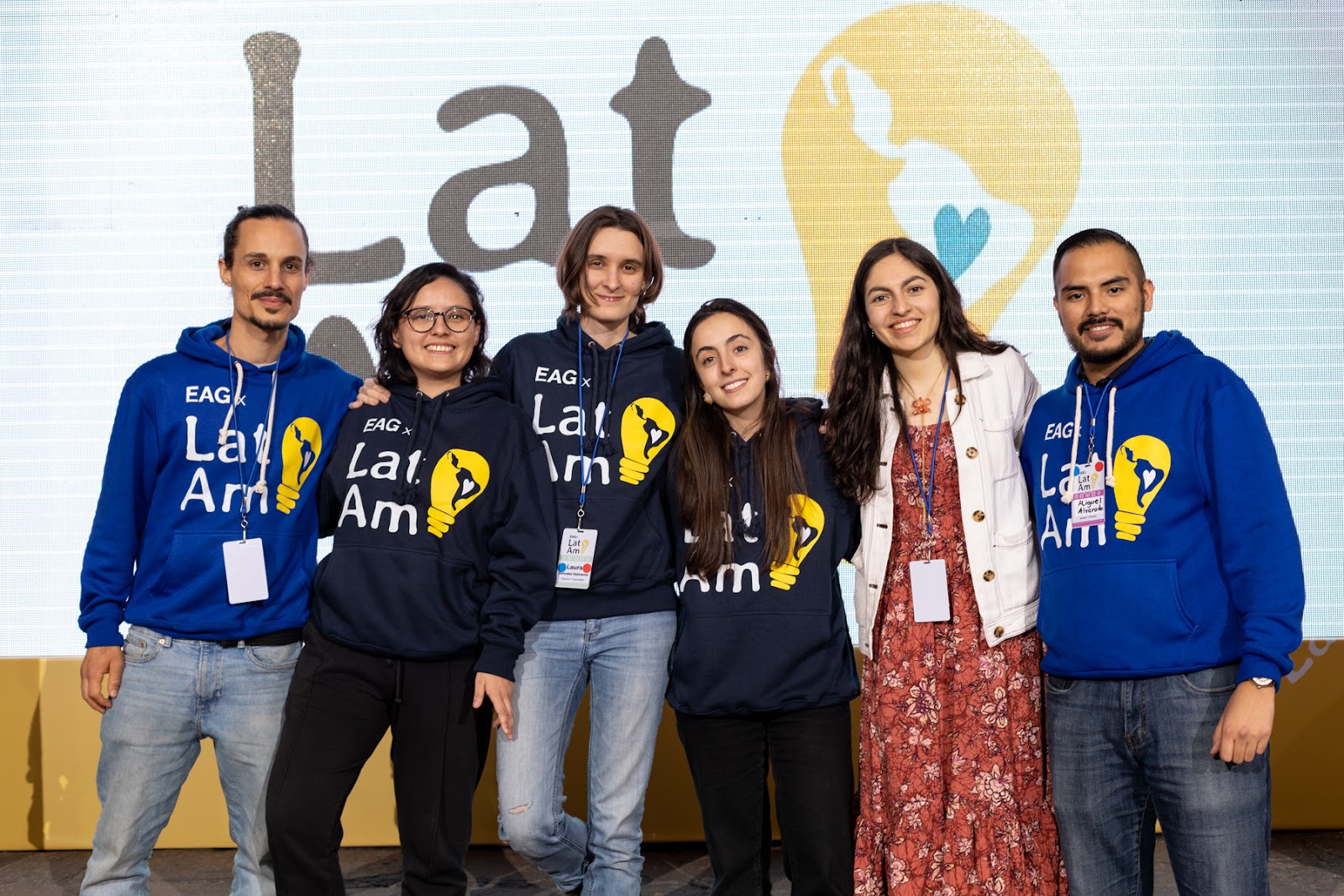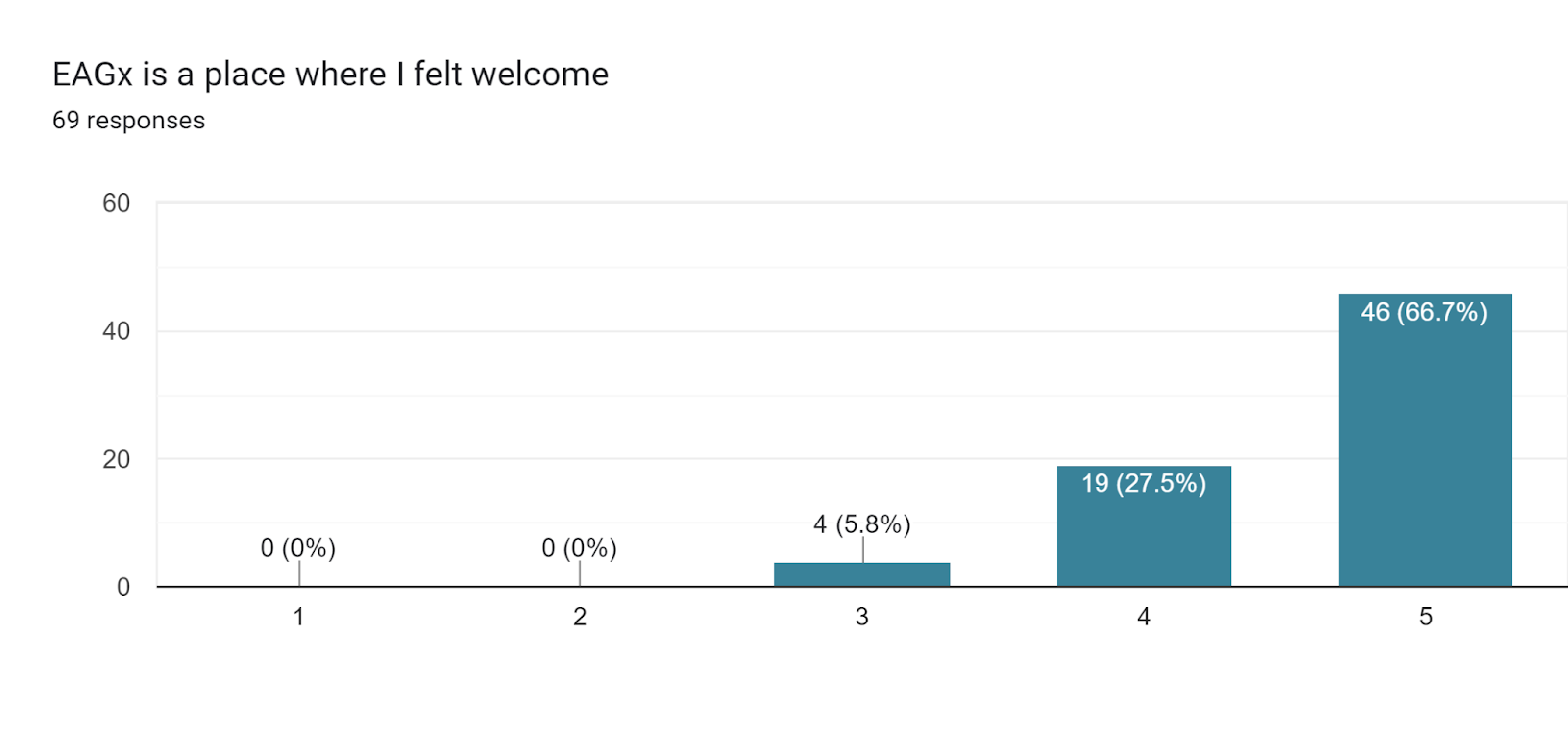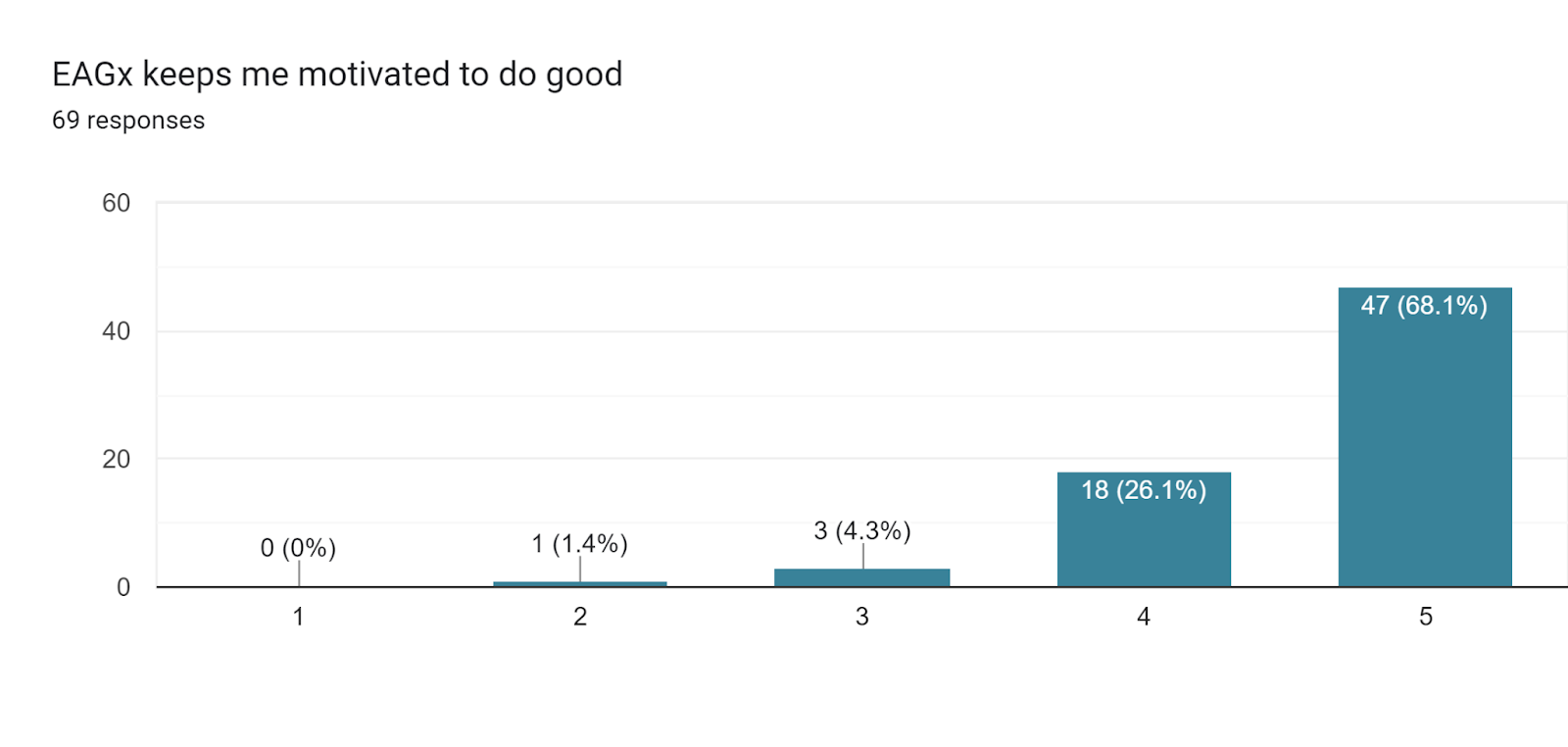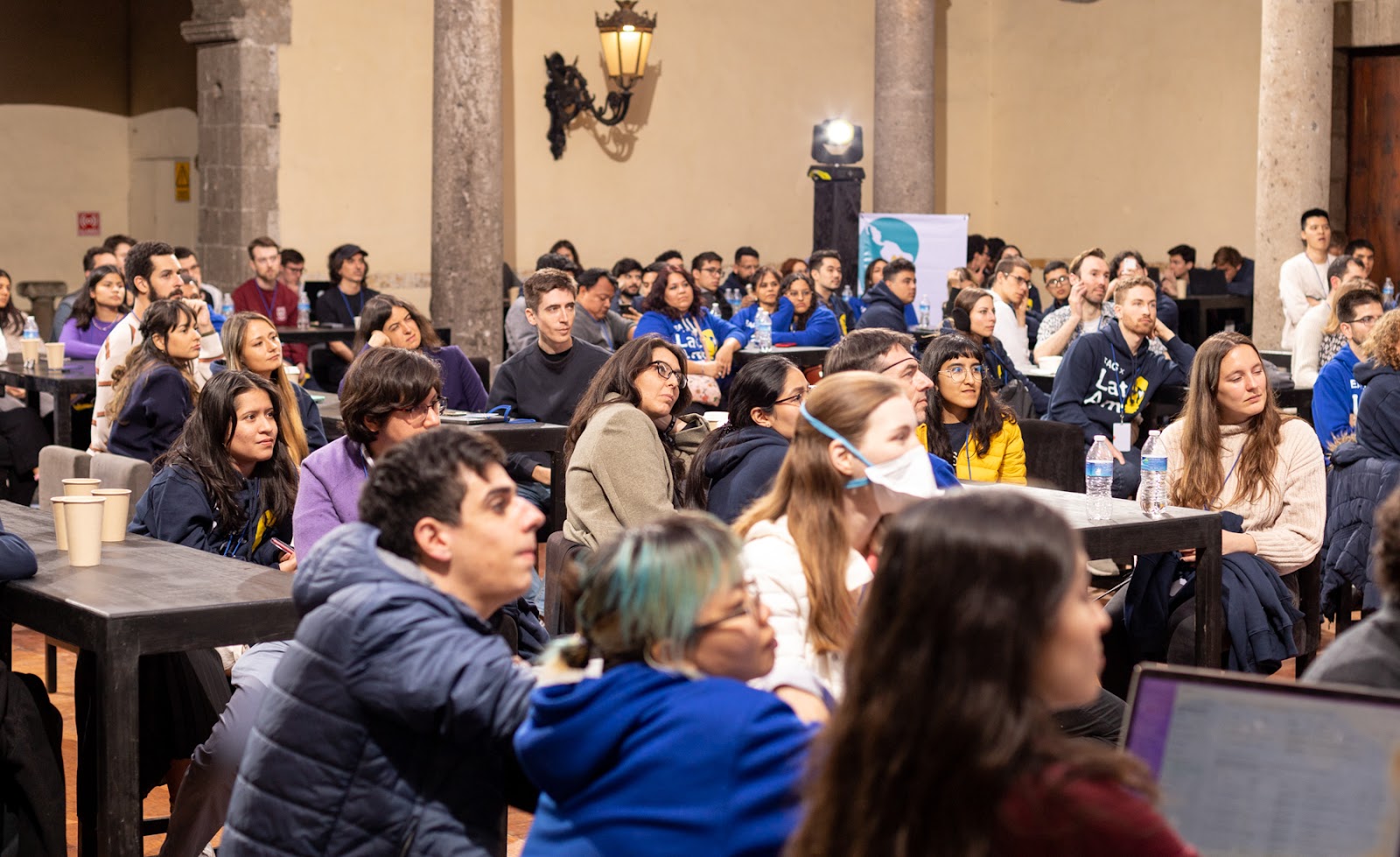Bottom Line Up Front: The first-ever EAGx in Latin America went well (97% satisfaction rate[1]). Participants generated over 1000 new connections at a cost of USD 225 per connection[2].

What is the purpose of this post?
The purpose of this retrospective is to give a brief overview of what went well and what we could have done better at EAGxLatAm 2023. I also hope that the last section will open a conversation to help EA community builders and EAGx organizers to measure the impact of their work and to decide how to best use their resources.
The first-ever EAGx in Latin America
It's with great excitement that we announce the successful conclusion of the first EAGx LatAm conference, held in Mexico City from January 6th to 8th, 2023.
The event drew a diverse crowd of over 200 participants from 30 different countries. Our goal was to generate new connections between EAs in Latin America and to connect the LatAm community with the broader international community.
Video highlights of the event:
The conference featured a wide range of content, including talks and panels on topics such as forecasting, artificial intelligence, animal welfare, global catastrophic risks, and EA community building. Notably, it was the first EAG event featuring content in Spanish and Portuguese.
We're grateful to have had the opportunity to bring together such a talented and passionate group of individuals, and we hope to see even more attendees in the future. Special shoutout to the unofficial event reporter Elmerei Cuevas for his excellent coverage of the conference on Twitter, using the hashtag #EAGxLatAm.

Key Stats[3]
- 223 participants (including 46 speakers)
- 1079 new connections made[4]. That’s 9.68 new connections per participant.
- Over 1000 one-on-one meetings, including the first recorded instance of a one-on-twelve
- 61 talks, workshops and meetups
- Cost per connection: USD 225[5]
- Likelihood to recommend: 9.08/10 with 75% of respondents giving a 9 or 10/10 rating and 3% of respondents rating it below 7/10. (Net promoter score: +72%).
Some of the survey results




Goals
Our main goal was to generate as many connections as possible for every dollar spent.
We expected the number of connections per participant during EAGxLatAm 2023 to exceed that of any previous EAG(x) conference. While we generated significantly more connections per participant than the average EAG(x) conference, we didn’t break that record[6].
Also, we expected the cost per connection (number of connections/total budget) to be significantly lower than previous EAGx conferences. We were a little too optimistic on that one. Our cost per connection could have been decreased significantly if we had more attendees (more info below).
We aimed at achieving the following key results
- Every participant will generate >10 new connections
- 10% of participants will generate >20 new connections
- Make sure ~30% of participants are highly engaged EA
We also aimed at limiting unessential spending that would not drastically impact our main objective or our LTR (Likelihood To Recommend) score.
Actual results
77% of participants generated >10 new connections (below expectations)
16% of participants generate >20 new connections (above expectations)
~30% of participants were highly engaged EA (goal reached)
Spending
We spent a total of USD 242,732 to make this event happen (including travel grants but not our team’s wages). That’s USD 1089 per participant.
Details
Travel grants: USD 115,884
Venue & Catering: USD 98,524
Internet: USD 6,667
Speakers’ Hotel: USD 9,837
Hoodies: USD 5,536
Photos & Videos: USD 5,532
Other: USD 813
What went well and why?
We didn’t face any major issues
Nothing went terribly wrong. We definitely reached the EAGx Handbook’s MVP of “getting lots of EAs in a large room and feeding them intermittently over a weekend”.
While there is always a part of luck in organizing events, a large part of the successful completion of EAGxLatAm was due to adequate planning.
Each team member knew what they had to do and who they should contact if they needed help. We were relatively well-rested and started the event free of responsibilities (besides whatever would arise as the event unfolded). We also really cared about the event and its potential impact so we proactively took every opportunity to improve it and make it run more smoothly.
People enjoyed the event
The feedback we received was above our expectations. When asked “How likely is it that you would recommend EAGx to a friend or colleague with similar interests to your own?” respondents rated us at 9.08/10, exceeding that of any EA Global conference in 2022.
Here are some additional survey results:

What people said about the event
- “[It was] a lot more "familiar" and cozy, connections made here seem to be a lot more intimate and sustainable than those formed at other conferences, a lot more "integrative" and welcoming into the space”
- “It was a wonderful experience. I think overall it was very well organised (except those few minor issues I pointed out as a volunteer), and I appreciate the great diversity of talks, types of sessions, and especially the attendants.”
- “In some respects it was better than some other EAG(x)'s, as people seemed particularly friendly and open to conversations even without scheduling an 1-on-1. I really liked the venue, especially the green area where we could walk during the 1-on-1s, and didn't notice any main problem with respect to infrastructure and organization.”
- “[It was] the best weekend of my life”
We focused on the essential
Having a clear goal helped us to focus on what really mattered. Every time we had to make a decision, we reminded ourselves: “Will this help generate more connections?”.
Depending on the answer, the person responsible for this task could decide how much time should be spent discussing this topic. Instead of talking about the ideal color of badges, we had more time to discuss our strategy for making sure people booked more 1-on-1s. This saved us a huge amount of time and headspace.
We received a lot of help
We could not have made it on our own. Over 60 people helped us make this event happen including:
- A contractor coordinating the venue, catering, and infrastructure installations who helped us to reduce the time spent coordinating and planning the event. Choosing reliable and experienced people who had already organized many similar events[7] was also a key point here.
- 40 highly-cooperative volunteers. We had a leader for every volunteer team (room managers, speaker liaison, logistics, and registration) and created Slack channels for each team to facilitate communication[8].
Volunteers took their work very seriously. They followed the volunteer schedule and we always had extra volunteers available when something arose. Being constantly surrounded by people willing to help made the organization of EAGxLatAm so much easier.
- We also received a great amount of support from the Centre for Effective Altruism (CEA). By providing their expertise, capital, and operational support, they demonstrated a real interest in bringing more geographical diversity to the movement.
Special thanks to Ollie Base for supporting us in the organization of the event. It was also very valuable to have Julia Wise bringing her community health experience during the conference.

Things we could have done better
Starting earlier
There are several things we should have done earlier including building our team and defining our goals.
- We defined our goals after some important decisions had been made (such as choosing the venue). I believe this should have been the first thing to do.
- We had our first team meeting only 1.5 months before the event. We would have been able to work more collaboratively and improve accountability if we had built our team with more anticipation and organized more regular team meetings.
Opening applications earlier and doing more promotion of the event
We expected 350 attendees but we only received about 300 high-quality applications out of which 283 people registered for the event. On top of that, 60 registered people did not show up to the event (that’s 21% of all attendees, much higher than the 10% no-show rate we expected).
Eventually, 223 people attended the event while we had already booked a venue for 350 people and food for 300 people. This seriously reduced the cost-effectiveness of the conference.
One of the main takeaways is that we should have opened applications earlier. We found out that we were not going to receive as many high-quality applications only about a week before the application deadline. It didn’t give us enough time to react.
We initially discussed promoting the event around universities but eventually decided to stick to EA channels, because we preferred to filter for more highly engaged EAs. At that time, we made a conscious decision to limit promotion, with the understanding that we'd favour quality over quantity but we were still hopeful that we would receive over 300 attendees.
If we had opened applications earlier, we would have been able to re-think our decision and do more promotion of the event.
We also had several people struggling to get their visa or travel grant on time, so opening applications earlier would have also helped in that regard.
Another option would have been to choose a small venue but, when we decided on the venue, we expected many people outside of LATAM to be granted travel support. However, due to the FTX situation, we had to limit our spending and lost many potential attendees for this reason.
We could also have tried to prevent having a high no-show rate. Maybe choosing a different date (more info below) and sending one more email asking people to confirm their attendance would have helped.
Choosing a different date
Organizing an event right after the end-of-year holidays was tricky. Most of the contractors we worked with were not working after Christmas, so reviewing final details during those days was hard.
A lot of CEA’s team and the EV finance team were also on holiday and it took them longer than usual to approve travel grants. Several people who asked for travel assistance for EAGx did not hear back from anyone until after the event and had to ask their families for money or cancel their trip.
Note that part of this issue was due to the fact that it’s more complicated to receive payments in Latin America than in most Western countries.
We would recommend future organizers to avoid organizing an EAGx conference between December 20 and January 15.
Negotiating more flexibility with contractors
The contacts we negotiated didn’t give us much room for change. We should have negotiated more flexibility early on to be able to adjust prices depending on the number of attendees. That’s especially true for food but we might also have been able to negotiate hotel prices this way.
Automating processes
There are several processes that we recommend future organizers and the CEA to automate.
Our CRM (Zoho) and event app (Swapcard) were not always set up properly which generated a lot of extra work (both on our end and on the CEA’s). Automating processes would also reduce confusion for attendees and allow them to plan their trip with more anticipation.
Offering more talks in Spanish
One of the most common feedback we received was that people would have liked more talks to be in Spanish. It makes sense for most talks to be in English since this is the lingua franca of the movement. However, language is still an important barrier for EAs in Latin America. We’ll keep this in mind for next time.

Quick thoughts on measuring the impact of EAGx conferences
Measuring the impact of EAGx, and community building in general, is hard. A lot of the total impact is indirect, long-term, and difficult to measure.
However, if we want to keep on investing resources in these types of gatherings, it needs to be aligned with the values of the movement. More than anything, it needs to be more cost-effective than other available alternatives. The first step is to make sure we measure the impact of every intervention within EA. Including EAGx conferences.
Since most of the impact of EAGx conferences comes from the networking aspect, I believe that we should divide the number of new connections generated by the budget spent to get the Cost Per Connection of every EA event.
Of course, not all connections are made equal. Some connections are much more valuable than others. Yet it can serve as a baseline to help people decide on the amount of resources that should be allocated to community building.
This could help future event organizers to focus less on the “likelihood to recommend” (LTR) score and more on the actual cost-effectiveness of the event[9].
Do you think the value of generating a new connection at EAGx is worth more than USD 225? How about USD 1000? Do you have other ideas for how to measure the impact and cost-effectiveness of EA conferences? I’d love to hear other people’s thoughts on this.
Useful links:
- More info about the Spanish-Speaking Effective Altruism Community
- The Spanish-Speaking Slack workspace
- ^
97% of respondents rated us ≥7/10 when asked the question “How likely is it that you would recommend EAGx to a friend or colleague with similar interests to your own?”
- ^
We don’t know yet whether this is cost-effective cost per connection. Hopefully, it can serve as a baseline for future EAGx conferences.
- ^
69 out of the 223 attendees filled out the feedback survey. The following stats were calculated based on those 69 surveys.
- ^
We define a connection as "a person you feel comfortable reaching out to".
- ^
Self-reported number of connections made/Total budget =1,079/242,793 = USD 225 per connection
- ^
EAGxIndia2023 recently broke the record with 12.36 new connections per participant. Really looking forward to hearing how they managed to generate so many connections.
- ^
They had organized events of this size and provided the same services (food, logistics, etc). However, they didn’t know anything about EA which generated minor unaligned decisions including: generating a lot of plastic waste, offering a non-vegan coffee creamer, thinking that we wanted the venue to look “prestigious” instead of trying to reduce costs, etc.
- ^
WhatsApp would probably have been a better option as some volunteers didn’t know how to use Slack.
- ^
That doesn’t mean that we should stop caring about the LTR score altogether. We could even combine both metrics by dividing the cost per connection by an index of the LTR. So, in this case, 225/0.9 = 250.

Nice post! I would've already said this in feedback but, to reiterate publicly: I thought that the first ever EAGx in Latin America went fantastically! :) Well done to you all!
Thanks Joel!
Love the cost per connection idea, I think it would be cool to calculate cost per impact and counterfactual adjusted connection (similar to how animal advocacy careers measures career impact)
Hi Vaidehi, thanks for your comment! Do you have any suggestions (or link to point me to) to help calculate that?
Hi Hugo, this is the metric: https://docs.google.com/document/d/1I0Ed8sYFLEKMlbPJG3SViqeE-POkDRASL0eE7fcjCn4/edit?usp=sharing
Great, thanks!
Thanks for sharing all these details!
Fantastic post i am delighted to read someone take a crack at an impact analysis of something abstract /reliant on 2nd order ripple effects; this has been something that has been bothering me